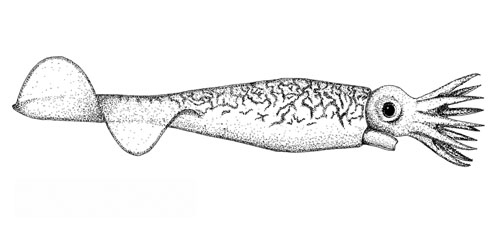
Belemnites are common fossils, and most collectors will have a few of these distinctive bullet-shaped fossils in their collections.
In fact belemnites have been recognised as something other than mere stones for thousands of years. Because of their remarkably phallus-like shape, the Ancient Egyptians associated them with male fertility god Min. Mediaeval Scandinavians believed that elves used them as candles, while in England they were called Devil’s thunderbolts and were thought to have been formed during lightning storms.
Belemnites even had magical uses. In pre-industrial England, one remedy for eye infections of horses was to grind up belemnites and blow the dust into the animal’s eyes.
But what sort of animals were belemnites? Where did they live and what did they eat? What was the function of that heavy, conical calcite structure we know today as the belemnite guard?
Fossils
When belemnite fossils are found, it is usually only the calcitic guard that is present. That the thing is made from calcite is unusual; most cephalopod shells are made from aragonite. This holds true for nautilus shells and cuttlefish shells today, and ammoniate shells in the past as well. In fact the chambered part of belemnite shells were made from aragonite and greatly resembled the chambered shells of other cephalopods. The calcitic guard itself fitted over the tip of the phragmocone. But aragonite is less stable than calcite, so the aragonitic part of the belemnite shell tends to be missing. By contrast calcite is very durable indeed: the author recalls finding hundreds of belemnite guards reworked into Pleistocene boulder clay at a quarry near Cambridge. Not only had these belemnites survived the tens of millions of year from the Late Jurassic, they had also put up with being rolled about by a glacier!
The chambered part of the shell is known as the phragmocone. It consisted of small chambers connected by a single strand of tissue, the siphuncle. As new chambers were added to the shell the siphuncle removed water from the chamber and allowed gas to diffuse in, so providing buoyancy for the animal.
In front of the phragmocone was an aragonitic spoon-like extension called the pro-ostracum that covered the mantle cavity. Unlike ammonite shells, which are external, all three parts of the of the belemnite shell were internal. Morphology
Occasionally fossils are found not only with the belemnite shell intact but also with traces of the soft body parts such as muscles and arms. These reveal that belemnites were broadly squid-like in shape.
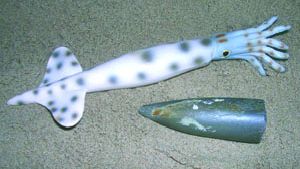 The phragmocone was in the middle of the animal, with the pro-ostracum projecting forwards above the mantle cavity. The guard was at the back of the animal, and worked as a counterweight, being used to balance the weight of the head and arms in front of the phragmocone. Without the guard, the belemnite would have tipped over, head downwards, and been unable to swim properly. Grooves on the left and right hand side of many belemnites have been taken as evidence of fins, the grooves likely being where the muscles were attached to the guard. By analogy with modern squid it is probable these fins were used in several different ways. When the belemnite was moving slowly, the fins would undulate and allow the animals to advance backwards and forwards, hover, or turn around. Where water currents were strong, the fins could be using for gliding. Like other cephalopods belemnites had a jet propulsion system that allowed them to move backwards very quickly, and to reduce drag the fins would be curled up against the body. The pro-ostracum lay above the mantle cavity. Its function was most likely skeletal and essentially similar to the rodshaped pen inside a modern squid, keeping the body stiff so that its streamlined shape was maintained. At least from the mantle cavity forwards, the body of a belemnite likely resembled the body of a squid rather closely, with the internal organs above the mantle cavity, the gills floating in the mantle cavity, and the head and arms in front of the mantle cavity. By contracting the muscular walls around the mantle cavity water could be squeezed out through a mobile nozzle called a siphon, and the resulting jet of water would provide propulsion.
The phragmocone was in the middle of the animal, with the pro-ostracum projecting forwards above the mantle cavity. The guard was at the back of the animal, and worked as a counterweight, being used to balance the weight of the head and arms in front of the phragmocone. Without the guard, the belemnite would have tipped over, head downwards, and been unable to swim properly. Grooves on the left and right hand side of many belemnites have been taken as evidence of fins, the grooves likely being where the muscles were attached to the guard. By analogy with modern squid it is probable these fins were used in several different ways. When the belemnite was moving slowly, the fins would undulate and allow the animals to advance backwards and forwards, hover, or turn around. Where water currents were strong, the fins could be using for gliding. Like other cephalopods belemnites had a jet propulsion system that allowed them to move backwards very quickly, and to reduce drag the fins would be curled up against the body. The pro-ostracum lay above the mantle cavity. Its function was most likely skeletal and essentially similar to the rodshaped pen inside a modern squid, keeping the body stiff so that its streamlined shape was maintained. At least from the mantle cavity forwards, the body of a belemnite likely resembled the body of a squid rather closely, with the internal organs above the mantle cavity, the gills floating in the mantle cavity, and the head and arms in front of the mantle cavity. By contracting the muscular walls around the mantle cavity water could be squeezed out through a mobile nozzle called a siphon, and the resulting jet of water would provide propulsion.
Predators and prey
Very occasionally fossils are found that feature parts of the body other than the skeletal remains. These so-called ‘soft body fossils’ have revealed that belemnites had an ink sac and arms covered with small hooks rather than suckers. The function of the ink sac was to make it easier for the belemnite to escape from predators. We know that at least some of the great marine reptiles of the Mesozoic ate belemnites because belemnite guards have been found in the stomachs of fossil ichthyosaurs. Unlike modern dolphins and whales, these reptiles hunted by sight rather than echolocation. Ophthalmosaurus for example is an ichthyosaur that had very large eyes that probably helped them find their prey at night or in deep water. One uncanny similarity ichthyosaurs shared with dolphins and whales is the tendency to evolve a long beak armed with small conical teeth. Seemingly this jaw design works equally well whether you’re snapping up slippery, fastmoving belemnites or squids!
Plesiosaurs and pliosaurs have also been found with belemnite guards and hooks in their stomachs, so these are known to have eaten belemnites as well. Sharks and other large fish ate them too; one famous fossil shark from Germany has a stomach that contains at least 250 belemnite guards!
It seems unlikely these animals digested the guards; after all, they’re mostly calcite and thus indigestible and being rather solid spikes could potentially harm the body organs as they moved along the digestive tract. Instead these predatory animals regurgitated the belemnite guards after they fed, in much the same way owls cough up the bones of their prey as owl pellets. Sometimes you can find these regurgitated masses as jumbled aggregations of guards mixed up with fossilised squid and belemnite hooks. Curious scratch-like marks on the belemnite fossils are now understood to be traces of the stomach acids that etched them while they were in the predator’s stomach.
Ecology
Belemnites themselves captured and ate small animals, likely fish and other belemnites. The hooks on their arms would work well for gripping slippery, slithery prey. What belemnites didn’t have are suckers on their arms, so in this regard they were very different to modern squids and cuttlefish. It isn’t known for sure if they are arms that could be rapidly extended like those squids and cuttlefish use to capture their prey.
Analysis of the oxygen isotopes incorporated in the calcium carbonate used by the belemnite to build its guard give another interesting insight into its ecology. Oxygen-16 is the standard sort of oxygen, accounting for just under 99.8% of the oxygen in the sea. Oxygen-18 is the next most common isotope, at about 0.2% concentration. What is particularly important for geologists looking at ancient climates is that the ratio of oxygen-16 to oxygen-18 depends in part on temperature: the colder the water, the more oxygen-18 there will be.
Because of this, as the belemnite grew, the calcium carbonate deposited as ‘growth rings’ would record the ambient oxygen isotope ratio at the time. In exactly the same way that tree rings can reveal whether a tree experienced a favourable year or a harsh year, the growth rings on a belemnite guard can be examined to determine how cold or warm the water was at the time.
The results are interesting, revealing that many belemnites were sometimes exposed to cold water conditions and at others to warm water conditions. Some argue this reflects migration up and down the water column between colder deep water currents and warmer surface water currents. Others suggest belemnites stayed at the same depth throughout their lives, but migrated between colder and warmer parts of the sea at different stages of their life. One broad consensus is that the cycling between cold and warm water conditions was an annual one, and by counting up the number of cycles you can estimate the age of the belemnite. If that’s the case, belemnites appear to have lived for several years rather than the one or two typical of modern squid. Squid live fast and die young: they grow quickly and once sexually mature mate, lay their eggs, and die. At places where squid spawn, the seafloor can be literally covered with thousands of dead squid.
But did belemnites engage in the same sorts of mass breeding events as modern squid? Huge collections of belemnite guards can be found at certain horizons, referred to by geologists as ‘belemnite battlefields’. But were these signs of love not war? Did belemnites mate in groups and the die shortly after laying their eggs? No-one really knows for sure, but this is certainly one interpretation of these belemnite battlefields.
The Aulacocerida
The Triassic cephalopods known as aulacocerids were the ancestors of the belemnites and represent a half-way house between them and the orthocone nautiloids. Like orthocone nautiloids they had long, conical shells with external ornament, typically longitudinal ribbing. But like the belemnites they were also equipped with guards around the tip of the phragmocone. Unfortunately not much is known about the aulacocerids, though it is assumed that they broadly occupied the same sort of ecological niches as the later belemnites.
Jurassic belemnites
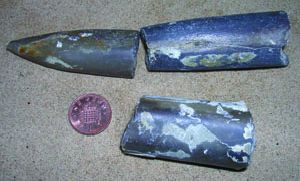 Belemnites became very common and diverse during the Jurassic. In the United Kingdom there are many good places to find Jurassic belemnites, including species like Cylindroteuthis puzosiana from the Oxford Clay and the many species of Hastites and Passaloteuthis that can be seen in the famous Belemnite Marls of Lyme Regis.
Belemnites became very common and diverse during the Jurassic. In the United Kingdom there are many good places to find Jurassic belemnites, including species like Cylindroteuthis puzosiana from the Oxford Clay and the many species of Hastites and Passaloteuthis that can be seen in the famous Belemnite Marls of Lyme Regis.
The typical Jurassic belemnite guard is bullet shaped with a deep conical recess into which the phragmocone fitted. Some species were also quite large; the guards of Cylindroteuthis puzosiana can get to about 15-20 cm in length, and the biggest belemnite guard known belongs to Megateuthis gigantea, specimens of which can exceed 45 cm in length. Deducing how big these belemnites actually were in life is difficult, but conservative estimates put the guard at about one-fifth the length of the whole animal. This would make adult Cylindroteuthis puzosiana up to a metre in length, and Megateuthis gigantea has been estimated at being slightly over three metres in total length.
Cretaceous belemnites
Many Cretaceous belemnites resemble their Jurassic forbears, but species of Duvalia are very distinctive. These belemnites didn’t have a conical guard but a slightly curved and flattened one that looked much like the blade of a bowie knife. Quite why this particular shape evolved is not at all clear!
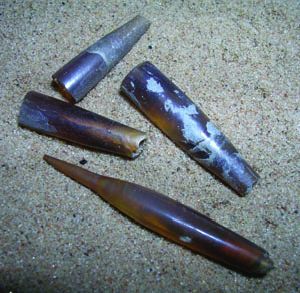 Duvalia isn’t present in the UK, but many other Cretaceous belemnites are very commonly found here including the very abundant little belemnite Neohibolites minimus. These can be found in the Gault Clay and are remarkable for their delicate construction and beautiful semi-transparent, amber-coloured preservation. They are only a few centimetres long, and in life these little belemnites were likely no more than 10-20 cm in length.
Duvalia isn’t present in the UK, but many other Cretaceous belemnites are very commonly found here including the very abundant little belemnite Neohibolites minimus. These can be found in the Gault Clay and are remarkable for their delicate construction and beautiful semi-transparent, amber-coloured preservation. They are only a few centimetres long, and in life these little belemnites were likely no more than 10-20 cm in length.
Where Jurassic belemnite guards are usually bulletshaped, Cretaceous belemnite guards often have a distinctive tear-drop appearance, with the thickest point not at the front where the guard meets the phragmocone but much further back. In effect this would be moving the centre of mass further back, away from the pivot point that is the phragmocone. Did this provide the belemnite with some functional advantage, such as better manoeuvrability or the ability to counterweight the headend of the animal using less calcite than otherwise?
Biostratigraphy
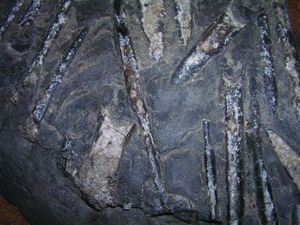 By comparison with ammonites, the value of belemnites for biostratigraphy is often said to be rather low. The problem is that belemnites tend to all look very similar, and there is nothing like the variation that there is with ammonites. But while working at the Natural History Museum in London, the author was able to use some belemnite guards to date a rock sample brought in by an oil prospecting company. The rock itself was so coarse that other fossils were lacking, and even the microfossils didn’t offer much help. But the belemnites were reasonably well preserved, and although the rock couldn’t be dated precisely, at least a ball park figure could be offered. One of the best known examples of a belemnite that has been widely used for biostratigraphy is the Mid Cretaceous species Praeactinocamax plenus, formerly known as Actinocamax plenus. The Plenus Marls that extend across much of Europe are named after this species, and are used to determine the boundary between the Cenomanian and Turonian stages. Another example of a belemnite used is Belemnitella mucronata, from which comes the Mucronata Zone of the Maastrichtian (Late Cretaceous).
By comparison with ammonites, the value of belemnites for biostratigraphy is often said to be rather low. The problem is that belemnites tend to all look very similar, and there is nothing like the variation that there is with ammonites. But while working at the Natural History Museum in London, the author was able to use some belemnite guards to date a rock sample brought in by an oil prospecting company. The rock itself was so coarse that other fossils were lacking, and even the microfossils didn’t offer much help. But the belemnites were reasonably well preserved, and although the rock couldn’t be dated precisely, at least a ball park figure could be offered. One of the best known examples of a belemnite that has been widely used for biostratigraphy is the Mid Cretaceous species Praeactinocamax plenus, formerly known as Actinocamax plenus. The Plenus Marls that extend across much of Europe are named after this species, and are used to determine the boundary between the Cenomanian and Turonian stages. Another example of a belemnite used is Belemnitella mucronata, from which comes the Mucronata Zone of the Maastrichtian (Late Cretaceous).
Extinction
Belemnites no longer swim in the sea. Quite why they died out at the Cretaceous-Tertiary boundary is a complete mystery. There were of course many different things happening during the Late Cretaceous, including climate change and changes in sea level. Various catastrophic events going on at the time included the infamous asteroid impact at Yucatan, Mexico and the massive volcanic eruptions in India that now form the Deccan Traps. Any of these might have been responsible for the final extinction of the belemnites at the K-T boundary.
But belemnite diversity was declining throughout the Late Cretaceous. It’s worth mentioning that at the same time the diversity of true squid was steadily increasing during this phase as well. Was this simply a case of belemnites dying out as the more advanced cephalopods took over?
Comparisons with modern squids
Belemnite-like squids have appeared throughout the Cainozoic, including some species that are still alive today. Strikingly belemnite-fossils referred to as Bayanoteuthis are known the Eocene, and some researchers consider them to be the last survivors of the belemnites that somehow made it through the K-T boundary. Others have interpreted them as fossils from some other type of cephalopod, or even a completely different type of organism such as a sea pen (a type of coelenterate).
The modern squid Spirula spirula doesn’t have a guard, but some of its close relatives such as Spirulirostra did. Cuttlefish sometimes have belemnite-like spikes at the end of their shells, and several squid have non-calcified but otherwise strikingly guard-like structure known as rostra that project from the back of the pen. In the case of large squids such as Onychoteuthis and Moroteuthis, the rostrum is made from chitin and supports the fins.
Like ammonites, belemnites are remarkable for being so familiar as fossils yet very mysterious as living things.
This article and all illustrations/photos © Neale Monks 2008, reproduced with the author’s kind permission from Deposits Magazine, Issue 16, Autumn 2008
Figures
Fig 1: Illustration of the Jurassic belemnite Cylindroteathis puzosiana
Fig 2: Comparing a life-size model belemnite with the common fossil find. The fossil belemnites are actually only a small part of the animal, since the soft tissue would have decayed away.
Fig 3: Cylindroteuthis puzosiana (Late Jurassic)
Fig 4: Neohibolites minimus (Early Cretaceous)
Fig 5: Acrocoeilites (Early Jurassic)
